#tolkien women
Text

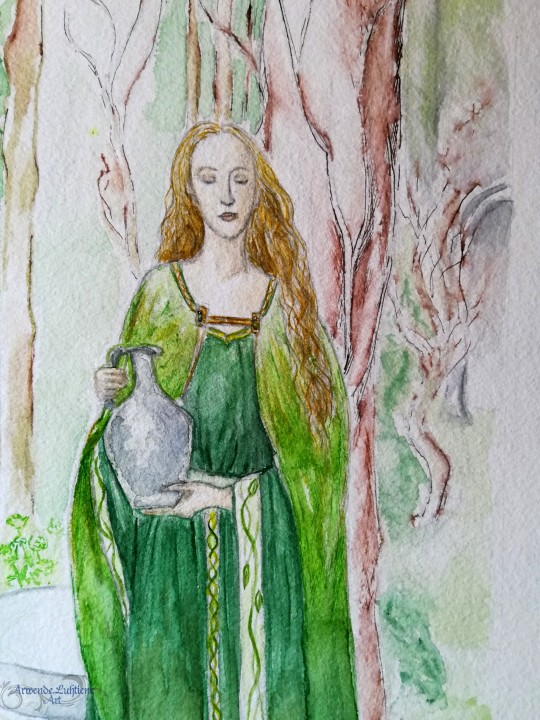


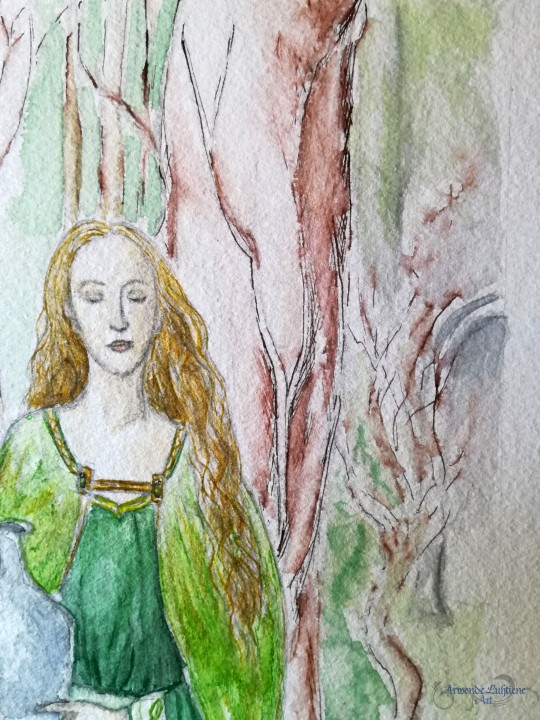
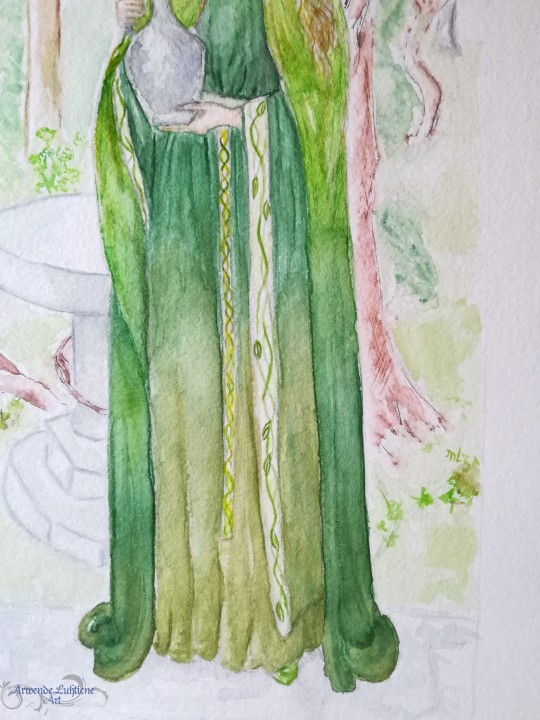
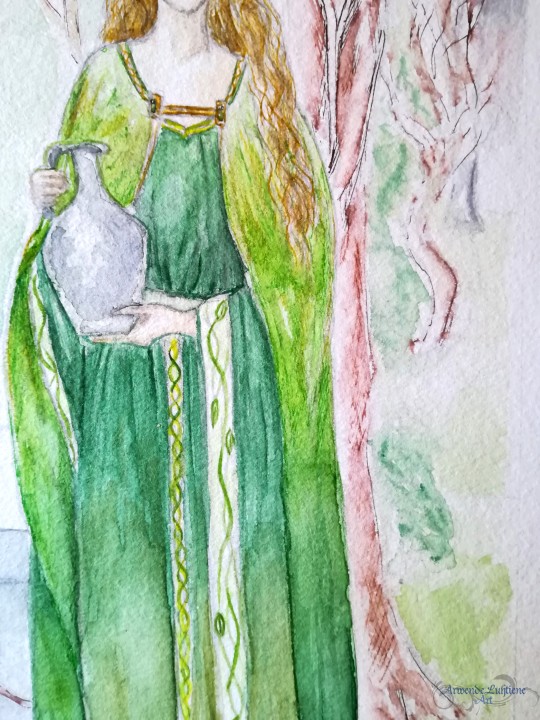

Happy Ostara/Easter/belated Spring Equinox 😊🌸🌿 🐰🥚🍫!
.
✨Valar and Valier series (late 2000s)✨ - 🌳🌿Yavanna Kementári🌿🌳 Initial practice sketch, the final painting and a couple of details.
.
I now prefer to headcanon Yavanna as dark-skinned, but I quite like how this watercolour turned out - especially the gradation of the different greens in the dress and mantle, and the trees in the background. I also love Alan Lee's original drawing on which this painting is based 🌿💚 (swipe for the comparison! Original is black and white, coloured by me as a guide for the painting).
.
Some years ago I started a 'Valar and Valier' project in which I took an existing painting/drawing as reference/inspiration to draw/paint one of the Valar. So far, I've done Varda, Yavanna, Nienna, Mandos and Aulë, and I also have some sketches of Nessa, Vána and Estë. Hope to get back to this project sometime!
.
. 🎨Media: Graphite, watercolours, inks, ink wash
. 🌱References: Alan Lee's drawing of the Celtic fae Ladies of the Land of the Young, for the book Faeries.
🎨ArtStation
🎨Instagram
🎨 DeviantArt
#tolkien#yavanna#tolkien art#silmarillion#silmarillion art#silmarillion fanart#tolkien fanart#yavanna kementári#My art#watercolour painting#alan lee#kementári#valaquenta#valier#valar#goddess art#lotr#lotr art#lotr fanart#lord of the rings#lord of the rings art#lord of the rings fanart#graphite drawing#watercolours#celtic culture#celtic mythology#irish mythology#faeries#tolkien women#ostara
83 notes
·
View notes
Text
It is not a betrayal to be happy while others are suffering. No matter what is going on in the world, in your life, or in the lives of those around you, you are allowed to do things you enjoy. You are allowed to smile. You are allowed to think about other things. Never taking time for yourself is not a sustainable or healthy strategy in any context, but especially not when you’re handling heavy emotional matters or working to make changes in the world. Those things are vital and important, but so are you, and without you, that important work couldn’t get done! So allow yourself to rest. To be joyful. To laugh and have fun. You—and life—are both complex enough to hold dualities.
Love,
Rosie Cotton-Gamgee
#rosie cotton#love from middle earth#self care#self love#tolkien characters#tolkien women#encouraging words#positivity#mental health#jrr tolkien#encouragement#lotr#middle earth#lord of the rings#tolkien#emotional health
371 notes
·
View notes
Text
I’ve only listen women who displayed stereotypical Girlboss behaviors in canon. Also Books only! I love Arwen with all my soul but she was unfortunately not a Girlboss in the books😔
#plz reblog!!! I wanna know!!!!!#polls#Tolkien#lotr#the lord of the rings#the silmarillion#Tolkien women#mine
18 notes
·
View notes
Text
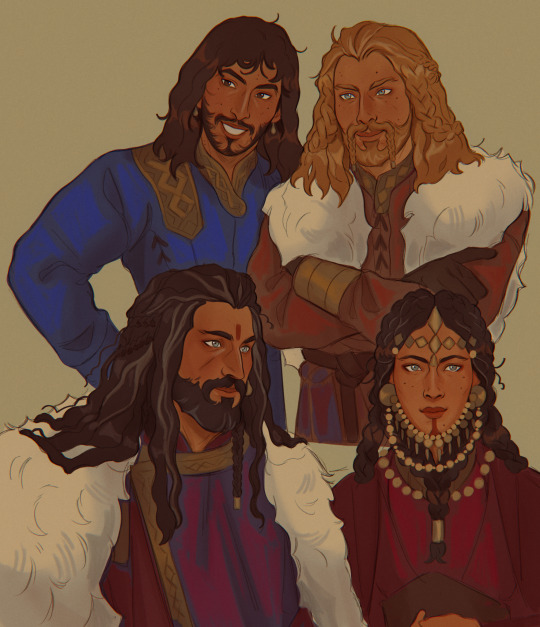
More House of Durin doddles!
#Just an excuse to draw Thorin again#Chuvash women wear beautiful pieces of jewelry around their faces#And I couldn't help but think it would be a cool concept to apply to Dwarrowdams#Can't say I nailed it this time tho#Also just realized I neglected Frerin#Too many tolkien characters I can't take it#the hobbit#tolkien#lotr#kili#fili#thorin oakenshield#dís#my art#art#artists on tumblr#artwork#illustration
3K notes
·
View notes
Text
So here's one of the coolest things that has happened to me as a Tolkien nut and an amateur medievalist. It's also impacted my view of the way Tolkien writes women.
Here's Carl Stephenson in MEDIEVAL FEUDALISM, explaining the roots of the ceremony of knighthood:
"In the second century after Christ the Roman historian Tacitus wrote an essay which he called Germania, and which has remained justly famous. He declares that the Germans, though divided into numerous tribes, constitute a single people characterised by common traits and a common mode of life. The typical German is a warrior. [...] Except when armed, they perform no business, either private or public. But it is not their custom that any one should assume arms without the formal approval of the tribe. Before the assembly the youth receives a shield and spear from his father, some other relative, or one of the chief men, and this gift corresponds to the toga virilis among the Romans--making him a citizen rather than a member of a household" (pp 2-3).
Got it?
Remember how Tolkien was a medievalist who based his Rohirrim on Anglo-Saxon England, which came from those Germanic tribes Tacitus was talking about?
Stephenson argues that the customs described by Tacitus continued into the early middle ages eventually giving rise to the medieval feudal system. One of these customs was the gift of arms, which transformed into the ceremony of knighthood:
"Tacitus, it will be remembered, describes the ancient German custom by which a youth was presented with a shield and a spear to mark his attainment of man's estate. What seems to the be same ceremony reappears under the Carolingians. In 791, we are told, Charlemagne caused Prince Louis to be girded with a sword in celebration of his adolescence; and forty-seven years later Louis in turn decorated his fifteen-year-old son Charles "with the arms of manhood, i.e., a sword." Here, obviously, we may see the origin of the later adoubement, which long remained a formal investiture with arms, or with some one of them as a symbol. Thus the Bayeux Tapestry represents the knighting of Earl Harold by William of Normandy under the legend: Hic Willelmus dedit Haroldo arma (Here William gave arms to Harold). [...] Scores of other examples are to be found in the French chronicles and chansons de geste, which, despite much variation of detail, agree on the essentials. And whatever the derivation of the words, the English expression "dubbing to knighthood" must have been closely related to the French adoubement" (pp 47-48.)
In its simplest form, according to Stephenson, the ceremony of knighthood included "at most the presentation of a sword, a few words of admonition, and the accolade."
OK. So what does this have to do with Tolkien and his women? AHAHAHAHA I AM SO GLAD YOU ASKED. First of all, let's agree that Tolkien, a medievalist, undoubtedly was aware of all the above. Second, turn with me in your copy of The Lord of the Rings to chapter 6 of The Two Towers, "The King of the Golden Hall", when Theoden and his councillors agree that Eowyn should lead the people while the men are away at war. (This, of course, was something that medieval noblewomen regularly did: one small example is an 1178 letter from a Hospitaller knight serving in the Latin kingdom of Jerusalem which records that before marching out to the battle of Montgisard, "We put the defence of the Tower of David and the whole city in the hands of our women".) But in The Lord of the Rings, there's a little ceremony.
"'Let her be as lord to the Eorlingas, while we are gone.'
'It shall be so,' said Theoden. 'Let the heralds announce to the folk that the Lady Eowyn will lead them!'
Then the king sat upon a seat before his doors and Eowyn knelt before him and received from him a sword and a fair corselet."
I YELLED when I realised what I was reading right there. You see, the king doesn't just have the heralds announce that Eowyn is in charge. He gives her weapons.
Theoden makes Eowyn a knight of the Riddermark.
Not only that, but I think this is a huge deal for several reasons. That is, Tolkien knew what he was doing here.
From my reading in medieval history, I'm aware of women choosing to fight and bear arms, as well as becoming military leaders while the men are away at some war or as prisoners. What I haven't seen is women actually receiving knighthood. Anyone could fight as a knight if they could afford the (very pricy) horse and armour, and anyone could lead a nation as long as they were accepted by the leaders. But you just don't see women getting knighted like this.
Tolkien therefore chose to write a medieval-coded society, Rohan, where women arguably had greater equality with men than they did in actual medieval societies.
I think that should tell us something about who Tolkien was as a person and how he viewed women - perhaps he didn't write them with equal parity to men (there are undeniably more prominent male characters in The Lord of the Rings and The Hobbit, at least, than female) but compared to the medieval societies that were his life's work, and arguably even compared to the society he lived in, he was remarkably egalitarian.
I think it should also tell us something about the craft of writing fantasy.
No, you don't have to include gut wrenching misogyny and violence against women in order to write "realistic" medieval-inspired fantasy.
Tolkien's fantasy worlds are DEEPLY informed by medieval history to an extent most laypeople will never fully appreciate. The attitudes, the language, the ABSOLUTELY FLAWLESS use of medieval military tactics...heck, even just the way that people travel long distances on foot...all of it is brilliantly medieval.
The fact that Theoden bestows arms on Eowyn is just one tiny detail that is deeply rooted in medieval history. Even though he's giving those arms to a woman in a fantasy land full of elves and hobbits and wizards, it's still a wonderfully historically accurate detail.
Of course, I've ranted before about how misogyny and sexism wasn't actually as bad in medieval times as a lot of people today think. But from the way SOME fantasy authors talk, you'd think that historical accuracy will disappear in a puff of smoke if every woman in the dragon-infested fantasy land isn't being traumatised on the regular.
Tolkien did better. Be like Tolkien.
#tolkien#middle earth#jrr tolkien#lord of the rings#lotr#the lord of the rings#eowyn#writing fantasy#fantasy#female characters#writing#historical fiction#medieval women#medieval history#medieval#history#womens history
8K notes
·
View notes
Text
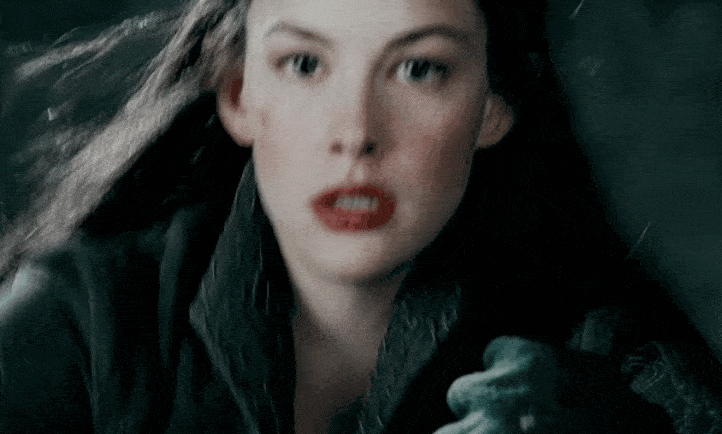
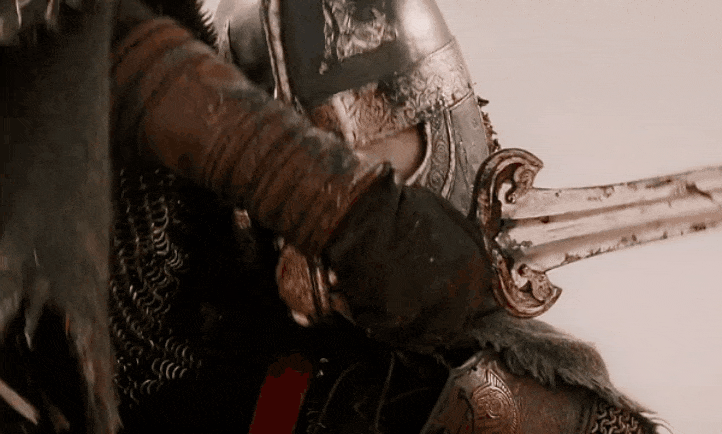
Happy International Women's Day 💗🌷
#lotr#lord of the rings#the lord of the rings#girl power motherfucker#eowyn#éowyn#arwen#lotr arwen#arwen undómiel#arwen evenstar#rotk#fotr#tolkien#lotr gifs#lotr edit#lotredit#middle earth#Middle-Earth#jrrt#international women's day
693 notes
·
View notes
Note
Sorry to send another ask in a short period but I LOVE your tags on the Elwing post and the cultural implications of the kinslayings. As always I appreciate your shining a light on Tolkien’s women so much
-@outofangband
❤️❤️❤️
0 notes
Photo

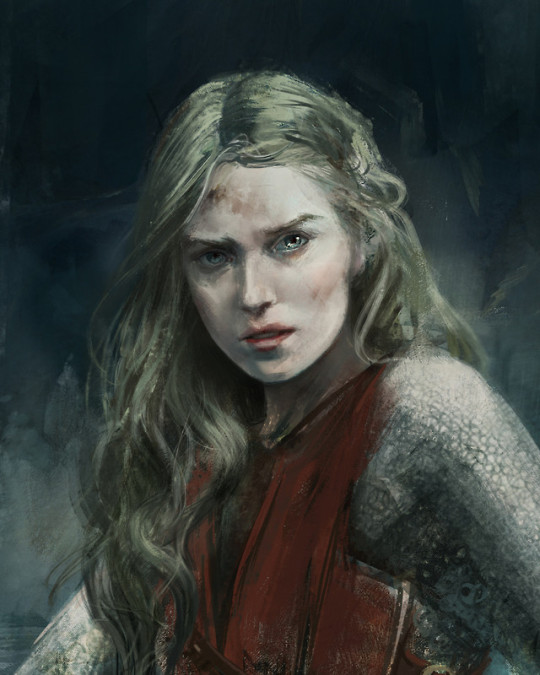
Éowyn
‘A sword rang as it was drawn. “Do what you will; but I will hinder it, if I may.”’
I painted this back in November 2017, on the kind request of Will o' Wisps for John Howe’s visit to AthensCon 2017. I had the good fortune to meet him there and give him a print of it. He had very kind words about it, leaving me on cloud nine, because Howe is one of my earliest art heroes.
The Lord of the Rings has very few women characters in it, something that has been the point of criticism almost from its publication in the 50s. It might be for this reason that Éowyn stood out for me, but also because I was moved by how much understanding Tolkien showed for her situation. When she wants to go to war, she is dissuaded by Aragorn, and is rightly bitter about it:
‘She answered: "All your words are but to say: you are a woman, and your part is in the house. But when the men have died in battle and honour, you have leave to be burned in the house, for the men will need it no more. But I am of the House of Eorl and not a serving-woman. I can ride and wield blade, and I do not fear either pain or death."
"What do you fear, lady?" he asked.
"A cage," she said. "To stay behind bars, until use and old age accept them, and all chance of doing great deeds is gone beyond recall or desire.”’
Tolkien gave Éowyn a voice, and not only that, but also a chance to prove her valour and to change the course of the history of Middle Earth as no one else but her could have. He wrote little of women, it’s true. The little he did write, though, was with deep humanity.
#Éowyn#eowyn#eilidh#eleni tsami#lotr#the lord of the rings#women in armor#women warriors#fantasy#Illustration#digital painting#tolkien
419 notes
·
View notes
Text
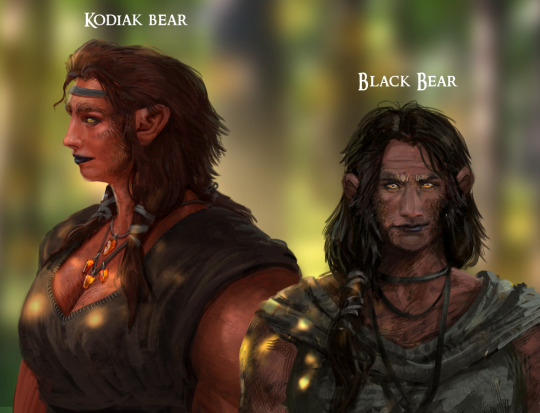
Bear women from Middle Earth
#beorning#beornings#beorning women#my art#the hobbit#tolkien#lotr#the lord of the rings#lord of the rings#the silmarillion#middle earth#jrr tolkien#tolkien fanart#skin-changers#western beornings#GIANT BEAR LADIES#yeee
503 notes
·
View notes
Text
eowyn should have been a lesbian. Eowyn/faramir is like, fine, but it misses the point of eowyn for all baby dyke eowyn stans which is not that she longs for glory in battle and doesn't realize war is ugly and brutal, but that she's caught between two awful options and she doesn't want to be given one based on her gender. She's not in love with aragorn, she envies him because she finds the tasks he has in life more preferable and she hero worships him. Is this the point Tolkien was trying to make? Well, no,
#look it is LESS objectionable than other similar fantasy storylines because tolkien is making a point about the brutality of war#but i do think he correctly observes a particular impulse in some women without fully understanding the underlying tensions#he's like. for reasons unknown some women would prefer to face horrible dangerous circumstances than stay at home & tend the family castle#don't you see the castle is the important thing!#the castle is more important yes that's not the POINT#anyway. it will not be until many years later that some of those baby dykes will be able to articulate the vague feeling of betrayal#guy jobs are horrible and exploitative too on this we agree. but you see some of us will die if we have to figure out how to be nurturing
271 notes
·
View notes
Photo

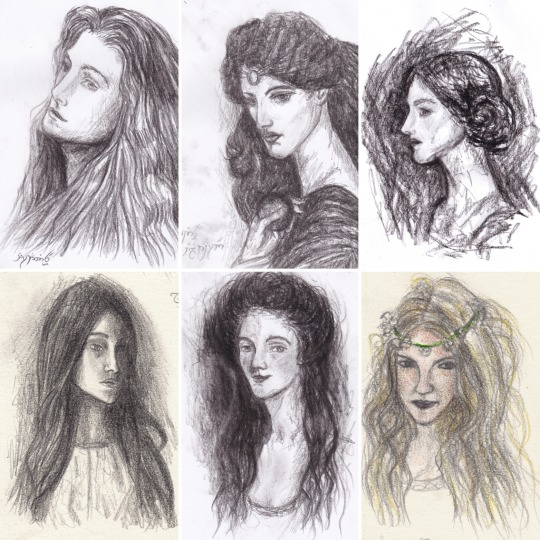


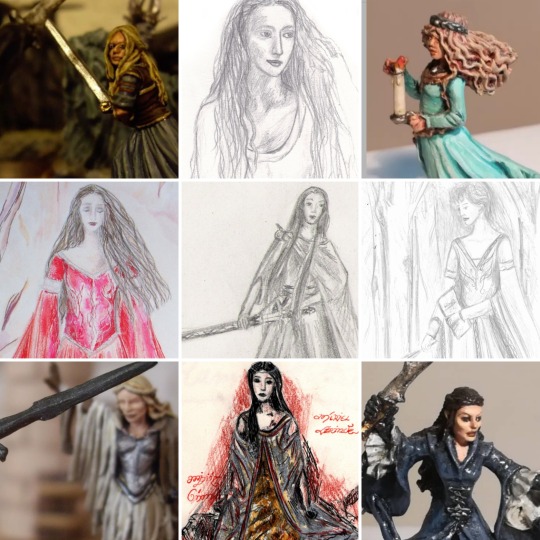
Tolkien women♀ ⚔️✨ for Women’s History Month and International Women’s Day - Several collages including 43 drawings, paintings and doodles of Tolkien women that I've done over the years, from mid-2000s to 2017-18. Hoping to do more Tolkien art this year 🎨😃!
These collages and merges include, apart from Elven and Dwarf women OCs: Galadriel, Lúthien Tinúviel, Arwen, Éowyn, Dís, Idril, Morwen, Nienor, Erendis, a Beorian wise-woman, Andreth, an Entwife, me and @tarmaerika as Tolkien characters, Varda, Yavanna, Nienna, Uinen, Elwing, Nimrodel, Celebrían, Míriel Therinde (with dark hair because typo xD), and Goldberry.
🎨ArtStation
🎨Instagram
🎨 DeviantArt
#tolkien women#international women's day#women's history month#tolkien art#tolkien fanart#tolkien#lotr#lord of the rings#silmarillion#lotr fanart#silmarillion fanart#galadriel#luthien#arwen#dís#eowyn#idril#morwen#nienor#erendis#varda#yavanna#nienna#uinen#entwives#andreth#nimrodel#celebrían#míriel therinde#My art
38 notes
·
View notes
Text
Regardless of your motivation, it takes time to make any life change, major or not. It’s a myth that struggling with effecting these improvements indicates anything about your willpower, your strength, or your merit. Whether it’s trying to cultivate or break a habit; end an unhealthy cycle, recover from a crisis, or any other change, you are doing something really hard and it’s natural for there to be obstacles and periods where you aren’t making the progress you’d like to. Though it can be really painful to feel like you’re sliding backwards after having succeeded, the fact that you’re trying at all is testament to your bravery and persistence. You are worthy of the same love, care, and support regardless of how much you struggle. No progress is made all at once--it’s the little changes stacked on top of each other that eventually build up to make a difference, and each of those little changes is valuable in itself. A bad moment or perceived failure is not the be-all-end-all of your journey. Be gentle with yourself: you’ll get there at your own pace. ♡
Love,
Nimrodel
#love from middle earth#the silmarillion#lotr#nimrodel#encouraging words#encouragement#positivity#self love#self compassion#lord of the rings#mental health#tolkien#tolkien women#self care
24 notes
·
View notes
Text

Eowyn ✨
#eowyn of rohan#illustration#lotr fanart#jrr tolkien#artists on tumblr#my art#digital art#women artists#drawing#art#fanart#procreate art#female artists#i am no man
2K notes
·
View notes
Text
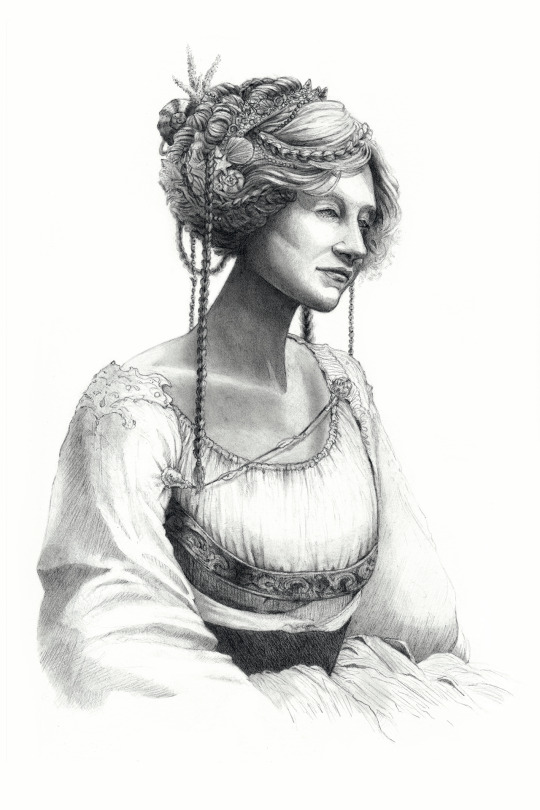
Eärwen
11x14 Stonehenge
graphite and charcoals
#silmarillion#earwen#the women of the house of finwe here i goooooooo#in no particular order#silmarilion fanart#women of tolkien
181 notes
·
View notes
Text
men who hate people having their silly little lotr ships are so silly and get so wound up about how someone else has interpreted a piece of fiction
like girl i literally don’t care if you don’t ship them why are you all up in MY business about how i’ve interpreted legolas and gimli’s ending as aligning with early-mid 20th century queer coding??
#lotr#lord of the rings#the hobbit#tolkien#gimleaf#gigolas#makes me angry and also amuses me#sure the dude who runs around singing silly songs isn’t at least a LITTLE BIT gay??#wdym most of the other male characters get married to women and have children?#and these two go off together and then sail to elf heaven??#like that’s basically how queer couples existed for a large portion of history
267 notes
·
View notes
Text
Ok, I said in this post that I wanted to talk about POV and what different characters would use for their species; I've been thinking about it for a while, because it's important to me to portray Elves as thinking of themselves as the default and I like having them think of mortals as different, as a way of worldbuilding and establishing POV. It's the same basic principle as why I think the War of the Elves and Sauron is a Númenórean name, not an Elvish one.
In brief: man and woman can and should be used to refer to Elves when writing from an elven POV.
I think about markedness a lot when I think about writing generally, and one of the concepts is that there are things that are unmarked, the standard, the default, the normal, the unexceptional. To an elf, the default species is elf, not human or dwarf or ent. I want to write from that POV - to an elf, humans are different, even alien. They're other. Elves are us, humans are them.
I, meanwhile, am writing in English, and man and woman are common words, the most "unmarked" words for the concepts; they're standard (e.g., woman sounds more normal than female human). Something like elf woman or female elf is more marked. Why would an elf use a more marked term to refer to their own race? Using she-elf or whatever for Elves but woman for humans uses more marked words (more uncommon, more specific, etc) for elves than it does for humans - but for elves, it should be the opposite! Elves are unmarked! Elves are default! Humans are different. If an elf is talking about someone, the default assumption would be that the someone is an elf, so if they're not an elf, it would be specified.
So when writing from the POV of an elven character, I would use woman for a female elf and mortal woman for a female human (if necessary to disambiguate). Man, meanwhile, means "Human" when it's capitalized and male when it's not. (Now, if I were writing from a human or dwarven pov, I would use elven woman, if necessary to specify that she's an elf.)
But, you say, what about using Elvish words? Well, first of all, I hate it. We're not writing in Quenya. English is great, and so are the other human languages people use to write fanfic. But that is a subjective matter of taste and you may disagree! Nothing wrong with that, de gustibus, etc.
More objectively, nér and nis are not words specific to Elves; nér means all males, so using it for specifically elf men and not human and dwarven men is incorrect (to quote Elfdict, "Nér can be used regardless of species and so is equally applicable to male Elves, Men, or Dwarves, but is unlikely to be used of male animals, for which the word [ᴹQ.] hanu is more applicable."") (Sindarin is a little more complicated, given the more complex out-of-universe changes, but it too has race-neutral terms for man and woman.)
Lastly, Tolkien himself uses man and woman to refer to non-human species. He calls Galadriel and Finduilas women, and Aredhel is "taller than a woman's wont." Earendil is a man (though he is not a Man) and Curufin is a horseman and there are lots and lots of kinsmen and kinswomen. Hobbits meanwhile, in Appendix F, have "women" and "man-children" (Tolkien is talking about how Hobbits name babies, thus the children part, but I like to think he's getting one more dig in at Pippin).
#meta#linguistics#writing#imo it's breaking pov to use 'man and woman' only for humans when writing from an elven or dwarven pov#the only time Man/Men means human is when it's capitalized#thanks to polu and aipi for examples of tolkien using 'man' and 'woman' to refer to non-humans#also man and women are great! i'm not going to abandon such useful words
123 notes
·
View notes